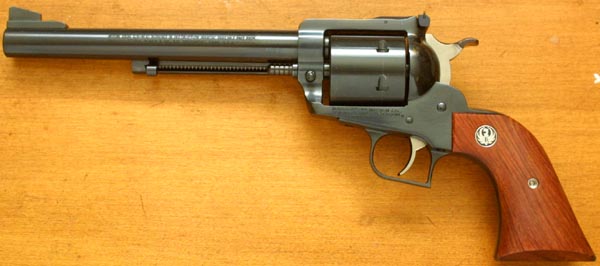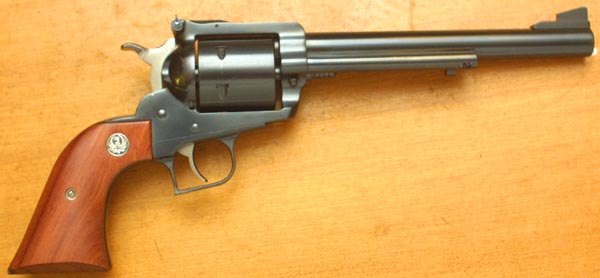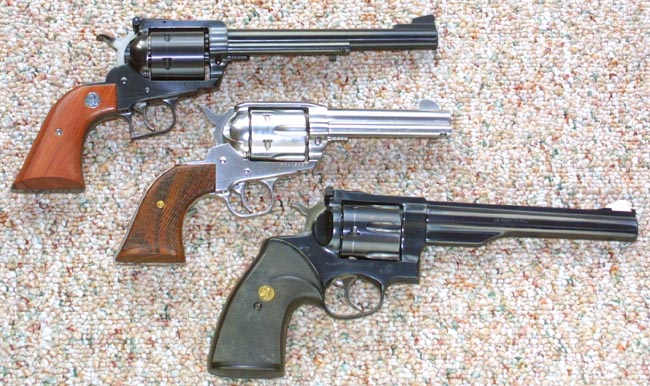 Super Blackhawk
Super Blackhawk
| Length overall | Barrel Length | Weight | Caliber | Action Type | Capacity |
| 13 3/8" |
7 1/2" |
48 Ounces |
44 Magnum |
SA Revolver | 6 |
 expensive and all but impossible to get, thanks to it's use and glorification
in the Dirty Harry movies. While people waited months to get their hands
on a genuine Model 29, and ended up paying triple the list price, the Super
Blackhawk could be had by simply walking into a gun shop, and paying over
the rather reasonable retail price. The Ruger, at the time, sold for $189,
which was about the same as the retail price of the S&W. The going price
of a Model 29, at that time was around $220. Of course, no one ever saw a
Model 29, in those days, for less than $500 - $600.
expensive and all but impossible to get, thanks to it's use and glorification
in the Dirty Harry movies. While people waited months to get their hands
on a genuine Model 29, and ended up paying triple the list price, the Super
Blackhawk could be had by simply walking into a gun shop, and paying over
the rather reasonable retail price. The Ruger, at the time, sold for $189,
which was about the same as the retail price of the S&W. The going price
of a Model 29, at that time was around $220. Of course, no one ever saw a
Model 29, in those days, for less than $500 - $600. A Ruger Blackhawk was the first 44 Magnum handgun that I had ever fired. This was back in the late seventies, when magnum fever, and the influence of Dirty Harry were both at their peak. No one that I knew had a Model 29; but a member of my circle of friends did own a Blackhawk. We all went out to the home of a friend of mine, who lived out in the country, where it was legal to discharge firearms. We had planned to make a day of it. I brought a Colt 1911, along with my old Dan Wesson 357, my old S&W Model 59, and a Remington 870 shotgun. Of course, the highlight of the day was getting to shoot the 44 Magnum. We all took turns with the gun. Expecting to be hammered by the recoil of the big 44, I was pleasantly surprised. The gun kicked, of course; but was quite manageable. It was also surprisingly accurate. I hit everything that I aimed at. There were four of us there, shooting up the woods, shooting at cans, and having what we told ourselves was a manly good time. During a period when the traditional sex roles were in transition, and the gay rights movement was in full swing, young men often looked for reassurance. Magnum handguns helped.
In 1956, having caught wind of the new big bore hunting cartridge being developed jointly by Remington, and S&W, Bill Ruger somehow got ahold of some examples of the new cartridge, and modified his Blackhawk design to chamber and fire the new round. The 44 Magnum version of the Blackhawk had an alloy grip frame, and was produced until 1963. These guns seemed a bit small for this powerful new cartridge, and the grips were a bit too small to comfortably soak up the massive recoil. Still, the guns had a certain following.
In response to some of the shortcomings of the 44 Blackhawks, Bill Ruger introduced a new 44 Magnum model, called the Super Blackhawk in 1959. He changed the shape of the grip frame, adopting the same style as that on the old Colt Dragoon black powder revolver. This gave a wider and more flowing grip, to help soak up recoil. At the same time he made the grip frame and ejector rod housing out of steel, rather than aluminum. He then left the flutes out of the .44 Magnum cylinder, giving the gun a distinctive new look. These changes also brought the weight of the gun up, another factor to help in controlling recoil. The Super Blackhawk was offered with a 7 1/2" barrel.
In 1973 Ruger changed its single action revolvers over to the New Model action style, employing a transfer bar ignition system which allowed the shooter to
The Ruger is a modern single action, in the sense that it does not presume to be an accurate copy of a more than 100 year old design. The Blackhawk has adjustable sights, coil springs, modern metal alloys, enhanced safety, and is designed for modern production methods. Bill Ruger once said that the Black hawk was his interpretation of the way that a single action revolver would have been designed, had the model first come into use today. With it's squared off top strap, ramp front sight, adjustable rear sight, and unfluted cylinder, the Blackhawk does not really look like a cowboy gun, except in the broadest sense. For those who are involved in cowboy shooting, or would just like something which has a more authentic look, Ruger began to produce the Bisley and Vaquero models. The Super Blackhawk is a considerably larger gun than the Colt Single Action Army, and requires a larger holster.
So much for the history; how does the gun shoot? In common with other traditional design single action revolvers, the grip frame of the Super Blackhawk rolls the gun back in the shooter's hand and absorbs a good deal of the felt recoil. This also tends to put the hammer right under the shooter's thumb, for recocking. This particular example is one of the New Model guns. The single action pull is nothing short of marvelous. It is light with a clean break. The adjustable sights are easy to see and use, though there tends to be a bit of horizontal play. The play in the rear sight is a common failing of this model, and is easy to fix with a vice and a punch. The first time I went out into the field with it, I shot one inch groups with this gun, the best groups I have ever shot in any gun of this caliber, with the sometime exception of my Dan Wesson.
These days, the recoil of the 44 Magnum has been far surpassed by several more modern rounds. Even so, it is still pretty impressive. The shape of the Super Blackhawk grips helps to moderate this a bit, and makes the gun a bit easier to shoot than some double action models. Of course, being a single action design, the Blackhawk is not exactly a rapid fire handgun; but then, the 44 Magnum does not exactly lend itself to rapid fire, no matter what the action type. S&W did eventually redesign the Model 29, somewhat, in the eighties, adding what they called the Endurance Package. This was due, in part, to the greater strength of the Blackhawk, which tended to cast a bit of a shadow over the older Model 29. I recall some old load books of mine, from the early eighties, which gave, in addition to standard loads, special loads which were only for use in the Blackhawk, and another series of special loads which were only for use in the Thompson Contender. Frankly, the standard loads are plenty, for all but the most hardy, and pain seeking gun enthusiasts. For such people, I recommend the Casull 454, or perhaps the new S&W 500 magnum, rather than attempting to push the 44 Magnum even farther than it has already been pushed.
Ruger now offers a pretty wide selection of single action, and double action revolvers. The double action Redhawk is now offered in several different calibers, and barrel lengths. It is
 also offered in blue and stainless finishes. The Blackhawk, and Super
Blackhawk have grown into a huge series of revolvers, including the Bisley,
and Vaquero models, in nearly any caliber you can think of including, at
one time, 9mm, and 30 carbine. The Blackhawk is now available in 480 Ruger
caliber, and we can always hope for other calibers to be introduced. Wouldn't
it be nice if Ruger would take a page from it's own book, and introduce
a model in 50 S&W, for those who can not afford to pay the $1000 price
tag on the new Smith and Wesson X frame guns.
also offered in blue and stainless finishes. The Blackhawk, and Super
Blackhawk have grown into a huge series of revolvers, including the Bisley,
and Vaquero models, in nearly any caliber you can think of including, at
one time, 9mm, and 30 carbine. The Blackhawk is now available in 480 Ruger
caliber, and we can always hope for other calibers to be introduced. Wouldn't
it be nice if Ruger would take a page from it's own book, and introduce
a model in 50 S&W, for those who can not afford to pay the $1000 price
tag on the new Smith and Wesson X frame guns. Ruger has become, as of the last couple of years. The nation' s largest gunmaker. It had long ago passed up Colt, and has more recently passed up Smith and Wesson. The reason for this was pretty obvious. The Ruger company was run by one man. Bill Ruger loved firearms. He collected, and shot, and was an enthusiastic firearms hobbyist. He designed and produced guns, not according to business models, or marketing forecasts; but according to what he himself wanted as a gun enthusiast. Bill Ruger was rarely wrong in his judgments. Bill Ruger died on July 6, 2002, at the age of 86. Who says the good die young? His son left the company in 2006.
A trio of Ruger six guns is shown in the photo to the right.
| Cleaning
the Blackhawk |
|
| A revolver is not field stripped, and need
not be disassembled in the manner of an auto loading pistol. Still, removal
of the cylinder is easily accomplished, and greatly eases the task of cleaning
the chambers. The process is started by depressing the locking pin, located just forward of the cylinder, on the left side of the frame. |
|
| The rod which holds the cylinder in place can
then be slid straight out. It is held in place by the ejector rod housing.
|
|
| With the loading gate open, the cylinder may then
simply be pushed out the side of the frame. This gives easy access to the
chambers, as well as to the inner portions of the frame and to the forcing
cone. |
|